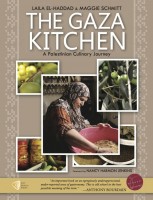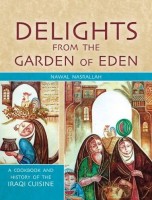 “Heh, that’s not a very thick book,” a visitor to my house wisecracked when he saw my copy of The Gaza Kitchen laying out.
“Heh, that’s not a very thick book,” a visitor to my house wisecracked when he saw my copy of The Gaza Kitchen laying out.
Woe to he who utters the untutored statement in my house! The guy got an earful of all the amazing things I had learned from this truly wonderful book: Gazans cook with dill and hot chili. They pound everything in clay mortar-and-pestles. There’s a hot debate over whether Gaza should even strive for food independence. And any Gaza cook worth her (it’s usually her, in this book) salt gives meat a quick boil first before doing anything else.
I see why this guy made this off-the-cuff lame joke. We in America don’t get a lot of information about Gaza, and certainly not about something so trivial as, oh, you know, food. This cookbook is a beautiful document of real daily Gaza life, which you never see. It has great photos of women at home, in their kitchens; of markets and ingredients; of street scenes. It talks about traditions, regional biases and yes, some political issues, which are of course sometimes impossible to extricate from our daily meals.
Every cuisine should be documented this way–not just through recipes, but with these generous biographies of the cooks, photos of techniques and ingredients, and discussions of food supply and how dishes are adapted due to non-food-related issues.
For instance: Gazans traditionally favors so-called “red tahini,” from toasted sesame seeds. But due to the blockade, it’s too expensive to make–so regular imported white tahini is used. I like to think that, thanks to the careful documentation of Laila El-Haddad and Maggie Schmitt, a detail like this won’t be lost in a few generations’ time. This cookbook brings a whole food tradition to light for those who haven’t known it, and it helps record it for those who cook it every day, whatever the circumstances.
Lecture over. Phew. Buy the book. If you don’t believe me, please note: Anthony Bourdain blurbed it!
***
 Two weeks ago, I got to meet Nawal Nasrallah, the author of Delights from the Garden of Eden, an Iraqi cookbook. It was just reissued this year, by a new press that invested in gorgeous color photos and more. Nasrallah was visiting NYC, and wound up cooking dinner at a friend’s house.
Two weeks ago, I got to meet Nawal Nasrallah, the author of Delights from the Garden of Eden, an Iraqi cookbook. It was just reissued this year, by a new press that invested in gorgeous color photos and more. Nasrallah was visiting NYC, and wound up cooking dinner at a friend’s house.
I was all breathless and told Nasrallah I’d had her cookbook for almost ten years, and loved it so much. “So, what have you cooked from it?” she asked me.
Er. Um. The thing is: every time I’ve decided to use the cookbook, I get distracted by the amazing historical details. The Akkadian etymology of seemingly every Iraqi food word. Odd factoids (Sumerian women called their husbands “honey man”!). An hour later, my head is full of fabulous stories, but I still haven’t decided what to cook. So I make a salad.
The dinner I had with Nasrallah was just the starting point I needed: red rice with chickpeas, lamb shank with raisins and almonds and onions, baklava filled with a delicate soft cheese. Oh, and the original “moussaka,” which has very little to do with the Greek stuff.
Nasrallah isn’t just a collector of recipes–she’s a scholar and a translator and has burrowed down into medieval cookbooks and back to ancient texts to really root Iraq’s food in place. The detail in this book is hilarious and enriching.
Buy it. Even if you never cook from it. Though I strongly suggest you do. That baklava with cheese is dreamy…